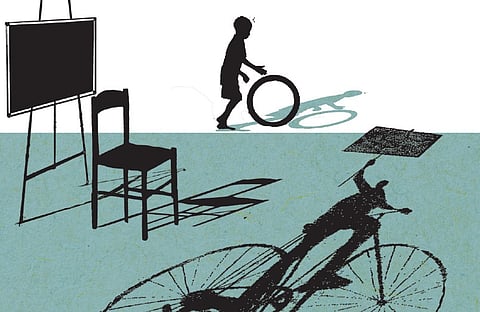

Three important reports released recently fill the educational policy quiver with pointed arrows. The canvas of the Annual Status of Education Report (ASER), the All India Survey of Higher Education (AISHER) and the Department of Economic Affairs (DEA) Indian Economy Review is a triple prescription for a hitherto non-existent integration of school, teacher and higher education ecosystem.
Such an integration is one of NEP 2020’s desired objectives which requires a seamlessly intertwined education value chain partnership than an isolated education value chain ivory tower leadership. Independently, the school education, teacher education and higher education amongst themselves are beginning to shape their own policy contours using NEP chisels, while collectively they still have a lot of common ground to cover.
The mixed bag across the three streams is characterised by improving school education enrolment and the burdening competitive exam frenzy fuelled by the JEE/NEET/CLAT mania, improvised integrated teacher education programme (ITEP) in limited HEIs and the rest in their own island marooned from realities and improved employability of graduates despite higher education tantalisingly blurred by exotic derivatives like phygital, online and hybrid modes. The need to build a coherent synergy by harnessing the positives and addressing the concerns is more tellingly visible now, than ever. Here is more.
The 2022 ASER is to be viewed by progressives as a glass half full to be filled with NEP 2020 interventions. The three critical metrics of access, attendance and achievement have managed reasonable scores with access registering considerable progress in rural areas. The overall enrolment of students in age group of 6 to 14 is 98.2 per cent end of 2022 and rural school enrolment has seen a 10-year high.
Enrolment in government schools in all states have increased in the last five years. Covid has not impacted school attendance with students’ attendance being the same after normalcy restored and teacher attendance also improving. The achievement levels is a matter of understandable concern due to the Covidian learning loss.
This Covidian symptom was addressed by another Covid vaccine in the form of NEP 2020 which has slowly begun its vaccine administration through the 5+3+3+4 school education modular framework with a focus on achievement. The rationalisation of national competitive exams for professional college admissions by reducing multiple exams and creating the right mix of competitive exam-school exam scores with regional calibration is imperative to mitigate the coaching class syndrome that produces ‘studenoids’—student humanoids.
With improved enrolment and improvable attendance, the focus on school education towards achievement needs a partner in progress, teachers. The teachers produced by the teacher education ecosystem form the school education spine. The newly announced integrated teacher education programme, the national professional standards for teachers and the national curriculum framework for school education have to operate in unison for teachers, school administrators and teacher education institutions to harmonise their operations to maximise outcome.
The present silo-based model needs to be replaced with an integrated approach in the light of these three major reforms and the more to come from the NEP 2020 pipeline. The more distanced are these three stakeholders the less benefited is the school education system and the existing model of scattered excellence needs synergistic coherence.
The teacher education institutions (HEI) in the higher education orbit need higher ideals of purpose transcending conventional boundaries of minimalism. The latest AISHE has registered significant improvement in various important metrics and coupled with the mainstreaming of vocational education offers a bouquet-of-sorts for HEI. The NEP 2020-triggered skilling has achieved over 1.4 crore skilling of learners under the PM Kaushal Yojana and the Wheebox Employability Test Report shows a rise in employability of pre-final year and final year students from 33.9 per cent (2014) to 51.3 per cent (2024).
The current model of teacher education in HEIs needs massive disruption from all sides. Universities need to be autogenously empowered by NCTE to offer various teacher education programmes infusing the spirit of NEP 2020 in varied forms through academic freedom. The current regimental shackles need to be eased out through a coordinated effort to improve the ease of teacher education through skilling future teachers resulting in ease of learning at school education level.
Calibrated universalisation of ITEP across public and private HEIs, strategised synchronisation with comprehensive universities in their ongoing programmes and optimised digitisation of teacher education delivery are promising pole positions. As the race towards achieving excellence gets competitive, the trifecta of school, teacher and higher education have to get their acts together to begin a transformative journey.
S Vaidhyasubramaniam
Vice-Chancellor, SASTRA Deemed University
vaidhya@sastra.edu